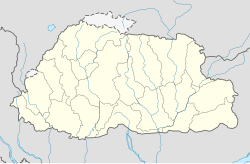Thimphu
|
ཐིམ་ ཕུ་ Thimphu |
||
|---|---|---|
|
|
||
| Coordinates | 27 ° 29 ' N , 89 ° 38' E | |
| Basic data | ||
| Country | Bhutan | |
| Thimphu | ||
| ISO 3166-2 | BT-15 | |
| height | 2320 m | |
| Residents | 114,551 (2017) | |
|
Center of Thimphu with the Wang Chu River |
||
Thimphu ( Dzongkha ཐིམ་ ཕུ་ , Tibetan transliterated: thim phu), with a population of 114,551 inhabitants (census as of May 30, 2017), is the capital of the Himalayan Kingdom of Bhutan . The city is located in the west of the country on the Wang Chu River at an altitude of 2320 m .
Political center
The Trashi Chhoe Dzong , a fortress-like monastery from the 13th century , restored and expanded in the 1960s, has served as the seat of the country's government since 1952 . The religious head of the country, Je Khenpo, also resides here in the summer months . The king ( Jigme Khesar Namgyel Wangchuck ) has a study in the complex.
The Dechencholing Palace , the official residence of the king, is located in the north of Thimphu, other monasteries (Tango, Cheri) are in the immediate vicinity of the city.
Decision center

Thimphu is the seat of government, parliament and administration and thus the center of political decisions in the country. This is where decisions are made about the use of foreign funds for Bhutan's development planning. Thimphu is the seat of several diplomatic missions, especially the UN organizations operating in the country, development aid organizations and various non-governmental organizations (NGOs).
Development problems
The city's economic development has clearly benefited from the development aid. At the same time, however, Thimphu has made the change from a tranquil small town to a city with traffic and environmental problems (sewage, garbage). Youth unemployment , crime and drug problems are further undesirable phenomena of this modern development.
tourism
The airport is located southwest of Thimphu, 6 kilometers from Paro (IATA code: PBH). The social highlight for the city's residents and at the same time an attractive attraction for foreign tourists is the annual monastery festival Tsechu Thimphus in autumn. Most of the country's hotels are concentrated in the capital. With a view to celebrating 100 years of the Bhutanese monarchy , in 2007 thousands of visitors from all over the world were received in Bhutan.
Sports
The Changlimithang Stadium, located in Thimphu, is the largest stadium in Bhuthan with a total capacity for 25,000 spectators. Football and cricket can be played in the stadium and on the adjacent courts. The stadium is also home to Thimpu City FC football club, which last won the Bhutan Premier League in 2016.
Thimphu also has a 9-hole golf course, the Royal Thimphu Golf Club, which is very close to the center just above the Trashi Dzong. It was inaugurated in 1971 by King Jigme Dorji Wangchuk and can also be played by guests for a daily fee. Changlimithang Stadium
In 1983, the Olympic Committee of Bhutan was founded with its seat in Thimphu, which has been chaired by the king of the country since then.
Attractions
- Memorial chortens for King Jigme Dorji Wangchuk
- Manufactory for the manufacture of handmade paper products
- Museum of Traditional Textile Art of Bhutan
- National Library
- Nuns convent
- State emporium for craftsmanship
- Trashi Chhoe Dzong (monastery fortress and seat of government)
- Centenary Farmer's Market , weekly market
- Dechencholing Palace , main palace of the kings of Bhutan, seven kilometers north of the capital
- Buddha Dordenma statue
sons and daughters of the town
- Jigme Dorje Wangchuck (1929–1972), Druk Gyalpo (King) of Bhutan from 1952 until his death
- Jigme Singye Wangchuck (* 1955), King ( Druk Gyalpo ) of the Kingdom of Bhutan from 1972–2006
- Wangay Dorji (* 1974), football player
- Passang Tshering (* 1976), football player
- Dorji Dema (* 1983), archer
- Kunzang Choden (* 1984), marksman
- Jetsun Pema (* 1990), Queen of Bhutan since 2011
Web links
Individual evidence
- ↑ Kuenga Wangmo (Ed.): 2017 Population and Housing Census of Bhutan - Thimphu Dzongkhag . National Statistics Bureau of Bhutan, Thimphu 2018, ISBN 978-99936-28-64-4 , 4 (English, gov.bt [PDF; 1.1 MB ; accessed on July 20, 2018]).




